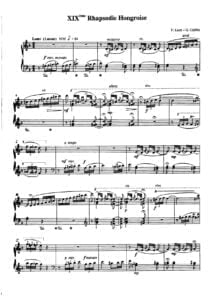Table of Contents
Come join us now, and enjoy playing your beloved music and browse through great scores of every level and styles!
Can’t find the songbook you’re looking for? Please, email us at: sheetmusiclibrarypdf@gmail.com We’d like to help you!
Cziffra Grieg – Improvisation on Peer Gynt op. 46-4.
Cziffra, Senlis, 7/88 Cziffra improvised on the theme ‘In the Hall of the Mountain King’ (Peer Gynt Suite).

Best Sheet Music download from our Library.

Please, subscribe to our Library.
If you are already a subscriber, please, check our NEW SCORES’ page every month for new sheet music. THANK YOU!
György Cziffra’s Improvisation on Grieg’s “In the Hall of the Mountain King”: A Volcanic Reimagining
György Cziffra (1921-1994) wasn’t merely a pianist; he was a force of nature. A Hungarian virtuoso forged in the crucible of war, political oppression, and personal tragedy, his playing combined staggering technical prowess with a wild, improvisatory spirit rarely heard on the classical concert stage. Nowhere is this more vividly displayed than in his infamous, electrifying Improvisation on Grieg’s “In the Hall of the Mountain King” (from Peer Gynt, Op. 46, No. 4). This isn’t an interpretation; it’s a complete volcanic eruption, reshaping Grieg’s iconic troll-march into a breathtaking, almost terrifying display of superhuman piano technique and raw musical imagination.

Understanding the Source: Grieg’s Original
Edvard Grieg’s “I Dovregubbens hall” (In the Hall of the Mountain King) is a masterpiece of orchestral storytelling. Composed for Ibsen’s play Peer Gynt, it depicts Peer’s terrifying encounter with the troll king and his grotesque court. Its power lies in its simplicity and relentless build:
- The Bass Ostinato: A single, creeping minor-key bass line (E – D# – E – F# – G) played pizzicato, representing Peer’s cautious steps or the trolls’ lurking presence.
- The Incremental Build: Layers are added systematically: first bassoons, then cellos/basses, then violas/violins, then brass and percussion. The texture thickens, the dynamics swell (from
ppptofff), and the tempo accelerates (Allegro molto - Meno allegro - Prestissimo). - Harmonic Stasis: It remains obsessively fixed in B minor, enhancing the feeling of inescapable menace.
- The Crescendo: The entire piece is one massive, inexorable crescendo culminating in a chaotic, crashing climax as Peer escapes and the mountain collapses.
It’s dramatic, effective, and relatively straightforward harmonically and structurally – the perfect canvas for a virtuoso like Cziffra to explode.
Cziffra’s Transformation: Technique as Alchemy
Cziffra’s improvisation takes Grieg’s core elements – the bass ostinato, the minor key, the relentless build, the sense of grotesquerie – and subjects them to a process of extreme pianistic alchemy. What emerges is something radically different yet undeniably connected to its source. Key characteristics of his approach:
- The Foundation: Octaves & Bass Reinforcement: Cziffra immediately establishes his power. The opening bass line isn’t just played; it’s hammered in thunderous octaves, often reinforced with additional lower notes or chords. This instantly creates a darker, more imposing, and percussive foundation than the orchestral pizzicato.
- Explosive Embellishment & Figuration: This is where Cziffra unleashes his legendary technique:
- Blurring Octaves & Tremolos: The simple melody line is transformed into a whirlwind of octaves played at breakneck speed, creating a shimmering, almost metallic texture. Tremolos (rapid alternations between two notes or chords) add intensity and volume.
- Cascading Scales & Arpeggios: Grieg’s incremental layering becomes torrents of chromatic scales, diatonic scales in parallel motion (often octaves or thirds), and sweeping arpeggios that engulf the entire keyboard. These aren’t just decorative; they are the primary drivers of the crescendo, creating immense sonic density.
- Glissandi: Cziffra frequently employs blistering glissandi (slides) up and down the white keys (sometimes black keys too), sounding like shrieks or the tearing of fabric. These add a visceral, almost brutal, element of chaos and danger.
- Lisztian Grandeur & Percussiveness: The ghost of Liszt, Cziffra’s spiritual ancestor, looms large. He uses the full, percussive capabilities of the piano – massive chords, sforzandi accents, staccato bursts – creating orchestral sonorities (brass blares, cymbal crashes, timpani rolls) but with a distinctly pianistic, sometimes savage, edge.
- Structural Expansion & Improvisatory Freedom: Cziffra stretches Grieg’s simple form. He introduces:
- Extended Introductions/Cadenzas: Often starting with dark, rumbling low-register explorations or dramatic chords before stating the theme.
- Developmental Sections: He takes fragments of the bass line or melody and subjects them to variations in different keys, textures, and tempi. He might suddenly shift into a contrasting, more lyrical (though still tense) interlude before plunging back into the maelstrom.
- Epic Climaxes: The final build is exponentially more intense than Grieg’s. Cziffra piles on layer upon layer of figuration – cascading octaves, tremolos, glissandi, pounding chords – often reaching speeds and volumes that seem to defy the physical limits of the instrument and the human hand. The climax isn’t just loud; it’s cataclysmic.
- Harmonic Intensification: While anchored in B minor, Cziffra spices the harmony liberally:
- Crushed Notes & Cluster Suggestions: Rapid adjacent notes create dissonant clusters, adding grit and tension.
- Chromatic Sideslips: Sudden, unexpected harmonic shifts using chromatic movement intensify the sense of unease and grotesquerie.
- Altered Dominants & Diminished Chords: Used more freely and aggressively than Grieg to create sharper dissonance and drive.
- Tempo & Rubato as Weapons: Cziffra employs extreme tempo fluctuations. He might begin slower and more ominously than Grieg, then accelerate ferociously. He uses massive rubato – holding back dramatically before unleashing a torrent of notes, or rushing headlong into a climax. This constant push-and-pull heightens the drama and unpredictability, making it feel genuinely improvised in the moment.
- Theatricality & Visceral Impact: This isn’t polite concert music. It’s a sonic assault. Cziffra plays with such physicality and abandon that the performance becomes a visceral spectacle. You feel the pounding bass, you see the blur of hands, you are overwhelmed by the sheer sonic mass and velocity. It captures the grotesque, terrifying spirit of the trolls far more viscerally, perhaps, than Grieg’s more controlled orchestration.

Why Improvisation? Context is Key
Understanding Cziffra’s background is crucial to appreciating why he approached music this way:
- Gypsy Roots & Cabaret Beginnings: Cziffra started playing in Budapest bars and circuses as a child prodigy. Improvisation, flashy technique, and captivating an audience with sheer bravura were essential survival skills. This background never left him.
- The “Outsider” Virtuoso: Despite his classical training (briefly with Dohnányi) and competition success, Cziffra was often viewed with suspicion by the classical establishment. His style was too wild, too personal, too reminiscent of the “low-brow” entertainment world. This improvisatory approach was a defiant assertion of his unique musical identity.
- Channeling Adversity: Cziffra endured imprisonment, forced labor, the loss of his sister and daughter, and the struggle to defect from Communist Hungary. The almost superhuman energy, the volcanic outbursts, and the moments of poignant reflection in his playing feel like direct expressions of a life lived with extreme intensity and suffering. The “Mountain King” improvisation channels rage, terror, and a desperate, exhilarating energy.
- The Lisztian Legacy: Cziffra was the 20th century’s most potent inheritor of Franz Liszt’s mantle. Liszt, the ultimate virtuoso-composer-improviser, famously improvised and created fantastical transcriptions of others’ works. Cziffra’s Grieg is firmly in this tradition – taking a known piece and using it as a springboard for personal, virtuosic fantasy.
Reception and Legacy: Genius or Vulgarity?
Cziffra’s improvisations, particularly the Grieg, were and remain controversial:
- Critics: Some dismissed them as vulgar, tasteless, technically brilliant but musically empty circus tricks, distorting the composer’s intent beyond recognition.
- Admirers: Others hailed them as breathtaking displays of unique genius, a revitalization of the Romantic improvisatory spirit, and a deeply personal, emotionally powerful response to the music. They argue that while not “Grieg,” it is undeniably great Cziffra – a phenomenon unto itself.
Where to Experience It:
Finding a single “definitive” version is impossible due to its improvisatory nature. However, several live recordings capture the essence:
- Live in Paris (1957): A relatively “early” documented version, already blisteringly fast and intense. [Search YouTube: “Cziffra Improvisation Grieg Mountain King 1957”]
- Live in Warsaw (1958): Often cited as one of the most ferocious and technically astonishing renditions. The speed and power are almost incomprehensible. [Search YouTube: “Cziffra Improvisation Grieg Mountain King 1958 Warsaw”]
- Studio Recording (1960s): While studio takes lack the absolute white-hot intensity of the live performances, they offer clearer sound and showcase the meticulous control beneath the chaos. Found on various Cziffra anthologies (e.g., EMI Classics).
What to Listen For:
- The colossal octaves anchoring the bass.
- The moments where the melody disappears under cascades of scales and arpeggios.
- The shocking glissandi – like nails on a blackboard, but purposefully so.
- The extreme tempo shifts and rubato – the dramatic pauses, the sudden accelerations.
- The sheer density of sound in the climaxes – how many notes can one piano produce?!
- The physicality – imagine the hands required to produce this sound.
- The grotesque, menacing, yet exhilarating atmosphere Cziffra creates.
A Unique Phenomenon
Cziffra’s Improvisation on Grieg’s “In the Hall of the Mountain King” is not a faithful rendition. It is a radical, personal, and technically superhuman reimagining. It takes Grieg’s simple, effective crescendo and subjects it to the full force of Cziffra’s unique musical personality, forged in adversity and rooted in gypsy improvisation and Lisztian transcendentalism. It is vulgar, breathtaking, terrifying, exhilarating, and utterly unique.
Whether heard as a desecration or a revelation, it stands as a monumental testament to the power of the piano and the volcanic talent of György Cziffra – a force of nature who used the keyboard not just to play music, but to unleash it. To experience it is to witness the boundaries of piano technique and expressive possibility being pushed to, and perhaps beyond, their limits.
Browse in the Library:
Or browse in the categories menus & download the Library Catalog PDF:
